Ferrari at Indianapolis: mutual love unanswered
1951: Ferrari and Indianapolis
Author
- Henri Greuter
Date
- December 5, 2012
Related articles
- March-Porsche 90P - The last oddball at the Indianapolis Motor Speedway, by Henri Greuter
- March-Alfa Romeo 90CA - Fiasco Italo-Brittanico, by Henri Greuter
- The Race of Two Worlds - The 1958 "Monzanapolis" bash, by Darren Galpin
- Ferrari at Indianapolis, by Henri Greuter
- 1952: Ferrari at Indianapolis
- 1956: A 'hybrid' against one of Indy's most persistent jinxes
- 1958: At home against Indycars
- 1961-1968: Of phantoms and enfants terribles
- 1971-1973: 'Meet my uncle Franco'
- 1975: A loud insect never leaving the chrysalis as was intended and hoped for…
- Intermezzo: Ferrari and turbocharging
- 1986: Projects 034 and 637, mere blackmail tools?
- 2000-2007: It's Indy, Gino, but not as we know it
- Appendix: The cars
What?Ferrari 340 Mexico Where?Cord-Auburn-Duesenberg Museum, Indianapolis When?Built for the 1952 Carrera Panamericana |
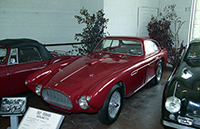 |
Why?
Ferrari was a new car manufacturer that had rapidly gained fame and reputation in Europe since it appeared on the scene shortly after the war. So much documentation about the origins and history of the company in the early years of its existence is found elsewhere that I will restrict myself to some basic relevant knowledge.
Ferrari had entered competition in both single-seaters and sportscars. In F1 it started with a 1.5-litre supercharged V12 but Ferrari could only win in events in which no Alfettas were entered. In sportscars the company burst onto the scene with some very decent results including victory in the first post-war Le Mans 24 Hours, in 1949. Soon, the young Ferrari company also had two Targa Florio wins and a Mille Miglia victory to its credits. In order to finance its racing programme, Ferrari also built street-legal sportscars that became in high demand.
In Formula One, Ferrari replaced the 1.5-litre blown V12 for a larger atmospheric engine, starting with 3.3-litre but increasing the capacity step by step to the permitted 4.5-litre. This V12 had two valves and a single overhead camshaft.
During the British Grand Prix at Silverstone of 1951, Ferrari won its first ever World Championship GP when Froilan González defeated the invincible Alfetta in a straight fight. Two more victories followed and Ferrari could have won the drivers title if they hadn't made the wrong tyre gamble in the final race of the season.
Meanwhile, an unsupercharged four-cylinder 2-litre Formula 2 car was active as well.
At the end of the year however, Ferrari had a worry. Its F1 cars appeared to become a victim of their own success. Alfa Romeo had announced its withdrawal from Formula One while Mercedes had shelved its plans to enter F1 with a car based on the 1939 W165 'Tripolis' car. That left Ferrari as the only decent F1 entrant since BRM that year had only entered its complicated V16 car in a single race (Silverstone). Despite its mind-boggling specifications, its reliability had been so appalling that few if any dared to rely on BRM as a worthy entrant for the upcoming GP season, organizers of Grand Prix races least of all. Most of them decided to run their events to Formula 2 regulations, which would guarantee a bigger entry. The best of these races also counted towards the newly created World Championship, held since 1950, which meant that the new World Champion would be driving a Formula 2 car to win the title.
The result was that the Tipo 375 F1 would no longer be seen in Grands Prix. Formula Libre was all that was left for them in Europe. The cars nevertheless had a future in the upcoming World Drivers Championship, even though it was for just a single race. But it would be a race on the North American continent, a new market with lots of potential for Ferrari.
The Indy 500 in 1951: The only way is up
A classic event before the war, the Indy 500 could have remained that and no more. The Indianapolis Motor Speedway was neglected during the war, with little if any maintenance having been done. Right after the war, thanks to the efforts of Wilbur Shaw, it was Terre Haute businessman Tony Hulman who took over the track from Capt. Eddie Rickenbacker. Hulman hired Shaw to revive the 500's former glory.
The first post-war 500 held in 1946 saw just two brand new cars compete but the event was a success, and the racing world resumed where they had left off in 1942 when WW2 had ended the development of racing cars.
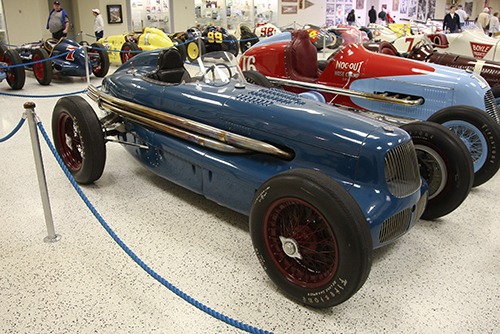
The first post-war 500 was won by George Robson in this Thorne Engineering Special, owned by millionaire Joe Thorne. A unique car among all Indy winners since it was only the second winner with a 6-cylinder engine: a 3-litre supercharged Sparks. The prize money Robson won for his team owner made up a bit for the loss of the second car, written off by Rudolf Caracciola in a violent practice crash. This car has beaten one of the most persistent jinxes at Indy in its entire history. More on that later on... (photo Mike George, used with permission)
More new cars appeared from 1947 on. Between 1947 and 1949 Lou Moore had a firm lock on the race. Moore had created two new well-thought out front-wheel drive cars that used a race strategy exploiting the strong points of the cars' design. Mauri Rose won in 1947 and 1948, ahead of his team mate Bill Holland, while Holland was victorious in 1949. Rose could have been second in that race if he had accepted defeat instead of making a do-or-die attempt to beat his team mate after all.
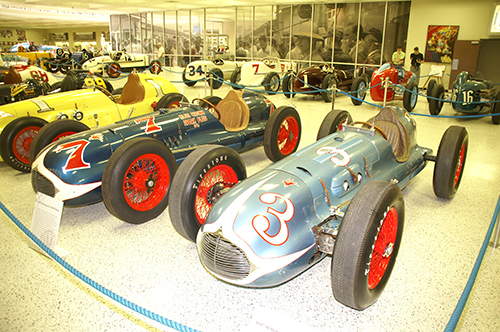
On the right the Blue Crown Special, driven from 1947 to 1949 by Mauri Rose, on the left the sister car driven by Bill Holland in the same period. Rose won in 1947 and 1948, Holland in 1949. Front-wheel-driven but light and very light on fuel consumption, and maintained in a manner that perhaps inspired Roger Penske, these cars had Indy to themselves during these three years. They are seen here together in the IMS Museum in May 2011. How many spectators realized that they were able to see these two cars 'tire shoulder' to 'tire shoulder' for the first time since how many years and perhaps for the last time ever? (photo HG)
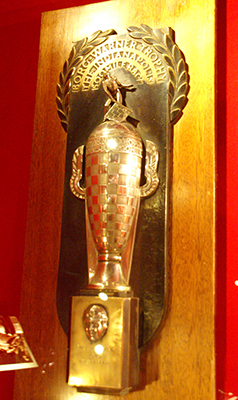
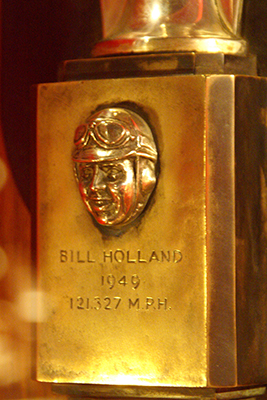
The famous Borg Warner Trophy is not to be kept by the drivers who won it. Instead, they receive a 1/4 replica of the trophy with a duplicate of the face that also appears on the real Borg Warner. For a while the awards presented to the drivers looked like this. This is Bill Holland's Award, on display in the Louwman Museum at The Hague, The Netherlands. Perhaps it's appropriate that at least one of the three Borg Warner Awards won by drivers with a 'Holland' connection went to Holland! (photo HG)
Front-wheel drive was still considered a concept having potential in 1950 and Holland could have been victorious again if the race hadn't been flagged off (due to rain) before Holland was able to make his final assault on leader Johnnie Parsons. Parsons had been driving a new brand of rear-wheel drive car built by Frank Kurtis, a car with the potential to outrun the heavily favoured front-drive Blue Crowns and Novis. More cars based on this concept would appear in 1951 while at the same time a new post-war generation of younger drivers, honed and skilled on dirt tracks, made their debut in the AAA series.
Car-wise there were indeed some changes in the world of Indycars but these changes restricted themselves to subtle chassis developments. The changes on the engine front had nothing to do with developments at all, perhaps even more with a lack of development. The few non-Offenhauser engines that were used since the rebirth of the “500” were fading from the scene. The unblown four-cylinder had the scene pretty much for itself with only the supercharged V8 Novi engine as a serious opponent.
For people not entirely familiar with the Offenhauser, let's clarify a few things regarding this engine affectionally called Offy: it had come into existence in 1932, first built by the Harry Miller Co. and was sold under the name Miller Four. When the company went bankrupt some of the inventory was taken over by shop foreman Fred Offenhauser who went on building the engine under his own name. After the war Fred sold out to Louis Meyer and Dale Drake who renamed the company Meyer & Drake Engineering and rechristened the engine Meyer-Drake-Offenhauser, although everyone kept talking about the Offy.
The Offy's fairly stunning success during the late forties notwithstanding the potential of blown engines was soon recognized. Even Meyer & Drake Engineering developed a blown 3-litre version of their four-cylinder, which debuted in 1951. Despite a power advantage the lack of torque compared with the unblown 4.5-litre handicapped the blown version severely.
In 1950, a World Drivers Championship had been founded, a series consisting of Grand Prix races in several European nations for cars built according to F1 specifications. To make it a more global affair, the Indy 500 was added to the schedule. Engine-wise, the “500” did not fully comply to the F1 rules, only halfway at best. Both Indycars and F1 allowed 4.5-litre unblown engines but while F1 accepted only 1.5-litre supercharged engines, Indy allowed blown engines of twice that capacity (3-litre). Prime reason for this was that when the “500” was revived after the war there was a dire shortage of blown 1.5-litre engines in the USA. In order to enable racing the old pre-war formula that allowed 3-litre supercharged engines was taken up with the intention to follow the Grand Prix formula later on. But when blown 1.5-litres remained rarities this rule change was postponed a first time, then a second time and eventually it never came of it at all. Because of this rule situation it could happen that a genuine pre-war 1939 Mercedes Grand Prix car (type W154 with M163 engine) appeared at the Speedway! The car in question was found in Europe, outside Germany, in an area once occupied by Nazi Germany. It was eventually bought by American Don Lee who fielded the car as the “Don Lee Special”, driven by Dennis 'Duke' Nalon in 1947 and by Chet Miller in 1948. The Don Lee team was however not the kind of team that could extract the maximum out of the highly sophisticated car and the car failed to finish in both years. It could have been an entirely different matter if the factory had given it a try at the Speedway with the examples of the car they still owned. Although such plans were made they never came to fruition.
Retaining the 3-litre blown engines was certainly helped by the fact that despite a potential power advantage only a single postwar “500” had been won by a blown engine, the 1946 race. There is no doubt that if there had there been an practical advantage for the blown engines and had they won the race with ease year after year this would have sparked off two effects. The first one would have been that more of these blown 3-litre engines would have appeared. The second would have been that a 1.5-litre limit might have been adopted after all.
There is a good explanation for the fact that supercharged engines remained such a rarity at Indy and in American single-seater racing in general. First of all there were no major car producers involved in single-seater racing. This meant limited funding for the development of supercharged engines. Privateers and rich men fielded the cars so the amount of sponsorship available certainly wasn't earth-shaking. Furthermore, most of America's single-seater races were held at unpaved oval tracks: not the conditions that particularly suited a sensitive supercharged engine. On such tracks the unblown Offy engines thrived, while the Offy also worked really well at Indy. This limited the use of supercharged engines and made them a questionable option for most teams participating in the Champ Car series. All of this combined ensured that Indianapolis retained the old pre-war GP formula for the 1950 race.
Thus, despite of the fact that it wasn't a race for true F1 cars, Indy became part of the World Drivers Championship from 1950 on. However, none of the American drivers who scored points for the 1950 and 1951 WDCs appeared in any of the European events, let alone that a European driver had tried to score additional points by competing at Indy. So one can only wonder about the effect the inclusion of Indy in the WDC really had, other that ensuring that at least on paper it wasn't an all-European series.
There is another curiosity worth mentioning. Despite a potential power advantage, the blown 3-litres made little impact during the 500-miles race itself in both 1950 and 1951. Both years the unblown 4.5-litre Offy had reigned supreme during the actual race. In F1, however, the unblown 4.5-litre cars didn't stand a chance against the supercharged 158 Alfetta since 1946, a situation that continued during 1950. It was only in 1951 that the unblown 4.5-litre became competitive against the Alfettas, as long as it was a Ferrari V12. The Ferraris only started beating the Alfettas in the latter half of the season, so well after the staging of the “500”.
Given the relative lack of success for blown 3-litres in the race, it must be highly doubted whether the highly tuned and highly stressed 1.5-litres Alfas would have had any chance against the regular Indy competitors, let alone the other blown 1.5-litres that were humiliated by the Alfettas.
The difference in maximum capacity allowed for blown engines wasn't the only rules difference between F1 and Indycars. Despite the fact that Indy had become a virtual playground for Offy-powered cars, the rules allowed other engine varieties than the usual 4.5-litre unblown and 3-litre supercharged units. AAA was interested in allowing technical variety and one option they allowed was for 6.6-litre diesel engines, be it normally aspirated or supercharged. The Cummins Diesel Engine factory had taken up this challenge by entering an Indycar powered by one of their 6.6-litre diesel engines, boosted by a Roots blower in an Indycar. The car was the slowest qualifier in the 1950 race and didn't make much of an impact but the exercise was interesting nonetheless.
Changes were to come for the Indy 500. The early post-war years had been an era in which the event was rescued from demise and a start of growth. 1951 had shown promise with new developments. The exotic front-wheel drive cars such as the Blue Crowns that were near invincible for a while as well as the powerful Novis appeared to lose their hammerlock grip at the Speedway. Newly built rear-wheel drive cars showed more promise than ever before. One constructor of such cars (Kurtis Kraft) produced them on request for all takers. The quality of the field improved which meant a number of chassis of pre-war origin - some of them dating back to the late twenties! - could finally be replaced by newer and faster cars.
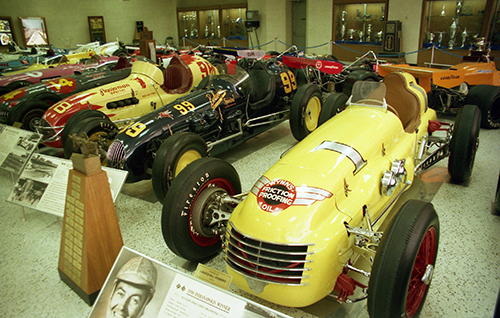
On the right is Johnnie Parsons' winning car in the rain-shortened 1950 race, on the left is the 1951-winning car driven by Lee Wallard. The #99 was more like a stretched midget. Indy was the only race in which it was driven by Wallard. The remainder of the season Tony Bettenhausen raced it to become National Champion. For Indy, however, Bettenhausen had put his faith in one in the fabled Blue Crowns whose days had just passed… (photo HG)
What's more, a new generation of young and upcoming drivers who almost grew up with these cars came along, ready to challenge the pre-war veterans. The future for Indianapolis looked bright for 1952 and beyond. Little known however is the fact that one party was working on making Indy even more attractive. The Road & Track magazine had been working on attracting European entries to the “500” in order to add more technical interest to the event.
The Carrera Panamericana factor
After the war, work was carried out to create a highway through the upper part of South America enabling a straight journey from North America to South America. Mexico finished its part in 1949 and celebrated this major event by organizing a car race starting in the northern part of the country, running over this newly finished road to end in the southern part of Mexico. Assistance to organize this event came from the USA and the race was open for four-seater production cars only. No modifications were permitted, apart from a few to improve driver safety.
The race consisted of nine special stages, boasted a total length of over 3400km and was held early May 1950. The competitors came primarily from Mexico and the USA. Bill France, who had founded NASCAR and was eager to promote racing with production cars was a major force behind the large American participation. Just about every brand of car built in Detroit was entered. Most of them were big lumbering saloons, close to two tons of weight. The most powerful ones had V8 engines up to some 160 to 180 hp. Only a few European cars had participated, the most important ones being two Alfa Romeo 6C-2500s driven by Piero Taruffi and Felice Bonetto. Both Alfas made it to the finish in the top-ten with Bonetto in 8th, while Taruffi gained a very honourable 4th. His underpowered Alfa had been blown away in the first high-speed stages, but in the second half of the race, uphill on twisty roads, the fine-handling Alfas gained back lots of time, yielding them the respectable classifications they eventually achieved.
Taruffi realized during the event that he had been too much of a gentleman and too good of faith regarding his opposition. Believing that all cars entered were strictly stock he had used the standard (105hp) version of the Alfa instead of a more powerful version which also would have been legal. The best of his American competitors, however, had stuck to the rules only to some extent. Improving the car's specifications was not done but with blueprinting and other tiny legal tricks you could turn your car into an exceptionally well-balanced example among the bunch of likewise cars. A Cadillac won one of the high-speed special stages with an average speed that was higher than the top speed measured for the car in a road test published in American magazines. No way that this was possible without at least some creative and methodical pre-race preparation.
Despite a few hiccups and some unforeseen details, the event was considered an astounding success. Mexico wanted more of it and announced a new race for 1951. Having learned from that first event, the race was moved to November 1951 and instead of 'going down' (from north to south) the race went the opposite direction, and the last stage (which had unpaved road!) was eliminated. With the most difficult stages at the start of the event, the field was bound to be decimated quickly, helping the logistics during the latter stages of the race. Not in the least because of the prize money involved, American drivers were keen on the Mexican event, yet again securing a large number of participants.
Piero Taruffi, road racer as he was, had also been full of praise for the Mexican Road race and promoted it in Italy. He also knew by now that the rules regarding the cars and their preparation were indeed strict but creative thinking, yet remain within the rules was beneficial. The Alfa had served him well in 1950 and Alfa could serve him even better with an even faster type. But there was another company in Italy which sold production cars that complied to the rules of the Carrera, but offered much and much more potential than the Alfas. And in fact more potential than any imaginable competitor the Americans could field.
The Mexicans lived up to their intentions and the second Carrera Mexicana was to be held from November 20th. This time, however, it was permitted to improve the cars, even though spectacular power-enhancing modifications were still outlawed. American drivers took the efforts to go south all the way and race back to their country.
Felice Bonetto was also entered for the event again. This year however he drove for Lancia. His former teammate Piero Taruffi had kept his promise and returned to Mexico as well, and like Bonetto, he would also drive something other than an Alfa. Unlike Bonetto who drove a Lancia (of which two were entered) Taruffi once again was part of a two-car team named Centro Deportivo Italiano SA. Also part of this team was Italian-born but American citizen Luigi Chinetti, winner of two pre-war Le Mans 24 Hours races (1932 and 1934, both with Alfa Romeos) and the first post-war edition when he won driving a Ferrari. Chinetti was to be Taruffi's co-pilot. Also present was Alberto Ascari, the man who earlier in the year had narrowly missed out on the World Drivers Championship. His co-pilot would be Gigi Villoresi. Four of the best drivers that Italy could be represented by, and the cars these four men would drive were as formidable as their drivers.
Ferrari did build production cars for interested customers who could afford them, using components derived from the racing cars fielded by the Scuderia. One of the cars on sale was the type 212 Inter Vignale powered by a 2.5-litre normally aspirated V12, yet still technically a four-seater although the rear seats offered little room and comfort. The engine produced some 160hp, the chassis had some pedigree in the sportcar world and handled fairly well. Even built as a four-seater the car was fairly light. Funnily enough, the drivers themselves were surprised to find out that when their cars were inspected and weighed they were much heavier than expected! Nevertheless, they weighed less than two thirds of the average American-built sedan entered for the Carrera. Those cars had at best something between 180 to 200hp at their disposal. If it came to power-to-weight ratio few if any of the American cars stood any chance against the Ferraris.
On the American continent and in Mexico the Ferrari brand was little known. The little company's year production was some 35 cars and few of them had left Europe. Ferrari's successes in racing also impressed few Americans. They didn't care about the three Grand Prix victories and while sports car racing was taking place all over in the USA there was no national competition. Interest for endurance events like Le Mans and the Mille Miglia was low as well so the larger audience didn't fully realize the potential of the Italian cars.
However, some drivers who had to compete against them certainly did. They realised their cars had little chance against the wolf in sheep's clothing these Ferraris represented compared to their Detroit hardware. So there were some complaints about the Ferraris not being genuine production cars, given the number of cars in Ferrari's annual production run and the prizes they were sold for: up to three times more than what you paid for a competitive American sedan. Still, nothing could be done, the cars and their drivers were there, they complied to the rules, if not quite to the spirit of these rules. So it was down to business.
The Ferraris had a long final-drive ratio in order to be speedy in the second part of the event, the long flat desert stages. The strategy was to remain in striking distance from the leaders early on in the mountain stages and run away from the field once out of the heights.
Taruffi/Chinetti drove chassis 163 EL, numbered 34, Ascari/Villoresi drove the 161 EL which carried number 9. Little could go wrong, yet that was what happened early on. The Pirelli tyres on which the Ferraris ran didn't have the stamina and blew ever so often, causing the cars to lose lots of time in the first special stages. Taruffi was 15th, Ascari 45th. The team then switched to far more durable Mexican-made tyres. From then on the race was effectively over. Coming from behind, the Ferraris worked their way up through the field. Taruffi was third after the second stage and took the lead after the fourth. Ascari was fifth after four stages, third after the fifth and second behind his teammate after the sixth. After that, there was no more real need to go flat out. They were still among the fastest cars on the last two stages but didn't put their upcoming double victory at risk anymore. Taruffi finished 8 minutes in front of his teammate, and some 15 minutes ahead of the third-placed car. It was a well-earned victory. Had the Ferraris used the right tyres from the beginning, their victory could have been even more convincing.
Only Tony Bettenhausen (AAA's National Champion that year) who drove a well-prepared Chrysler had been able to keep up with the Ferraris on the final stages, but he had lost far more time in the early stages than the Ferraris. Since only the first three finishers on the stages were paid prize money Bettenhausen went for top-three classifications in those final stages. He won the two last stages, yet failed to make the top-ten in the overall standings. Ascari won four stages, Taruffi one.
After the race there were still some complaints about the fairness of putting up disguised sportscars like the Ferrari against genuine production cars, but there were other competitors who felt that under the present rules the best car had won since there were a few very well-prepared cars at hand which were beaten by the Ferraris. The Kiekhaefer-prepared Chryslers for example, one of which was driven by Tony Bettenhausen, had little to do with the stock Chrysler. Kiekhaefer was reported to have spent some $59,000 on the two cars, a massive amount of money for that period of time.
One of the drivers who could accept defeat was Troy Ruttman, a 21-year-old up-and-coming driver in the AAA ranks. Ruttman's 1951 Carrera story was a remarkable one, almost the opposite to that of the Italian drivers. His co-pilot was a gifted mechanic, Clay Smith, who had bought a 1948 Mercury from a second-hand car dealer. He paid $1000, stripped the car down and prepared it meticulously for the Carrera. Ruttman and Smith had invested some $2000 in the car. But their “hand-me-down” served them well. They remained in the top-five the entire event, and even entered the top-three before the Ferraris arrived at the top of the leaderboard. Eventually they finished a very creditable fourth.
Ferrari's participation in the 1951 Carrera had several effects, some of which are way beyond the scope of this series, but here's a summary.
In order to avoid that 'Detroit's Best' was directly confronted with European sportscars for a second time, the Carrera organizers divided the field of future Carreras in two categories: one for sports cars and one for genuine production cars.
Clay Smith teamed up with mechanic Bill Stroppe and together they took up the preparation of the newly introduced two-door Lincoln Capri in a manner that matched the best factory efforts of the three Carreras that were yet to follow. In those three years, the team remained undefeated in its category, and out of a total of 24 stages the Smith & Stroppe Lincolns won 20 of them. One year they even won every one of them. Thanks to Smith & Stroppe the Lincoln Capri earned the distinction “Mexican Road Race Lincoln”. It became a forerunner of the so-called “muscle cars” but earned its credentials in straight competition and not because of paper specifications that still didn't turn the car into a hot competition car.
The Carrera Panamericana is an event whose importance shouldn't be underestimated. Did your realize that every Porsche Carrera of the past decades is a tribute to the successes of the young Porsche factory and their little sportscars?
The effects resulting from Ferrari participating in the 1951 Carrera for Ferrari's subsequent history as a whole must not be underestimated either.
For instance, Luigi Chinetti was rewarded for his share in the victory by Enzo Ferrari, who appointed him Ferrari's representative in North America. Such a role was needed by now since the Mexican success had put the Ferrari brand firmly on the American map. The Carrera was an appealing event for the North Americans, and by defeating Detroit's Best, Ferrari started selling cars instantly. The two Carrera participants were sold on the spot, saving the team shipping costs back to Italy. Meanwhile, Chinetti himself was to become a major factor in Ferrari history.
Yes, the second Carrera had been a very rewarding undertaking for Enzo - rewarding in the short term and offering lots of potential benefits for the future.
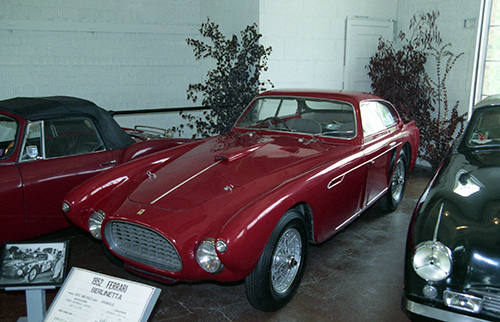
Like Porsche, Ferrari built cars named after the Panamericana. This is a Ferrari 340 'Mexico'. Three of these were built in order to compete in the 1952 Carrera. This is the one car that made it to the end, Chinetti & Lucas finishing third behind the two winning Mercedes 300SLs. Here it is seen in the Cord-Auburn-Duesenberg Museum in Indiana, USA. (photo HG)
The situation on the last day of 1951
The American market had become a viable option for Ferrari but Enzo was also stuck with a number of 4.5-litre single-seaters for which there was little employment left. Canibalizing them and using the parts in other cars was a possibility, but the cars as they were could only be used in one race of importance. That race happened to be held in America.
It was simply a case of 'one plus one equals ...'. Rarely the answer to that is something other than two.
Another benefit was that although Luigi Chinetti hadn't actually raced at Indianapolis, he did practice there in 1948, driving the Don Lee Special Alfa Romeo. So he knew at least something about the place. And if that wasn't enough: thanks to Bill Quinn of Road & Track Ferrari had been approached by, amongst others, Gerry Grant of the Grant Piston Ring company about obtaining a bunch of 375s. How much of an influence might the success have been that fellow Italian constructor Maserati had before the war, including two victories in 1939 and 1940? Was it appealing for Enzo to know that the Maserati that won at Indy had been a third-string Grand Prix car during its GP days while his cars had been top dogs or at least second-best in class? How much temptation could a man in his position stand?
And so, Enzo Ferrari decided that in 1952 he would send his cars to Indianapolis.
